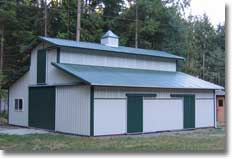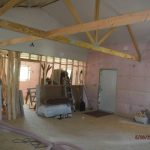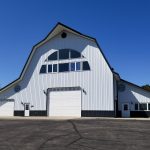 Call them “red iron”, “bolt up” or Pre-Engineered Metal Buildings (PEMB) or a variety of other names and they are great buildings. Where they especially shine is where roofs clear span over 80 feet and where very low slope roofs are desirable (typically less than 3:12). And no, I did not hit my head and you did not wake up in a different space-time continuum.
Call them “red iron”, “bolt up” or Pre-Engineered Metal Buildings (PEMB) or a variety of other names and they are great buildings. Where they especially shine is where roofs clear span over 80 feet and where very low slope roofs are desirable (typically less than 3:12). And no, I did not hit my head and you did not wake up in a different space-time continuum.
Roughly 40% of commercial buildings are steel farmed. Annually roughly 3000 U.S. residential homes are built using all steel frames.
Here is a dozen reasons (in no particular order):
1. When working within defined standard dimensions high-tech engineering and design software simplify processes and make for efficient use of steel.
2. As long as foundation bolts are properly placed and bolt holes are correct, no field structural steel cutting, welding or drilling should be required.
3. Building components and steel sheeting can be shipped from regional manufacturing and warehousing locations to minimize freight charges.
4. Fully engineered buildings with third-party engineered foundation plans, simplify permitting processes.
5. Steel has a very high strength-to-weight ratio. Obviously footprint, height, roof slope and manufacturer will come into play, however an average weight per square foot for a PEMB shell seems to be roughly eight psf (pounds-per-square-foot).
6. Once foundations are excavated, formed and concrete is poured, a contractor with proper heavy lifting equipment can erect a fairly significantly sized building fairly quickly.
7. Fire resistant metal framing does not ignite. With addition of 5/8” Type X gypsum wallboard, steel furring and appropriate insulation options one and two-hour exterior wall fire ratings can be achieved.
8. Insects do not eat steel
9. With high-quality paint on a proper galvalume or galvanized substrate, steel roofing and siding require very little upkeep.
10. Fully engineered, properly constructed steel buildings withstand damage from earthquakes, winds, snows, hail and other weather extremes as well as an equivalent post frame building.
11. Dimensionally stable steel changes little with temperature – in a variance of 100 degrees a 50 foot width building expands or contracts just under ½ inch. Steel does not change dimension with shifting moisture content like wood framing does.
12. Clear span steel buildings promise endless floor plan possibilities, with no restrictive load-bearing walls required.
 When you create an encapsulated building (spray foam to all interior surfaces), you do not want to ventilate it, as you would then lose your air seal. With your OSB’s underside sealed by closed cell spray foam and upper side protected with 30# felt or ice and water shield, there is no way for your OSB to become moist. If this is still a concern, an upgrade to plywood could be done.
When you create an encapsulated building (spray foam to all interior surfaces), you do not want to ventilate it, as you would then lose your air seal. With your OSB’s underside sealed by closed cell spray foam and upper side protected with 30# felt or ice and water shield, there is no way for your OSB to become moist. If this is still a concern, an upgrade to plywood could be done. We do have sample building plans available on our website for your builder to review and get a feel for
We do have sample building plans available on our website for your builder to review and get a feel for 





